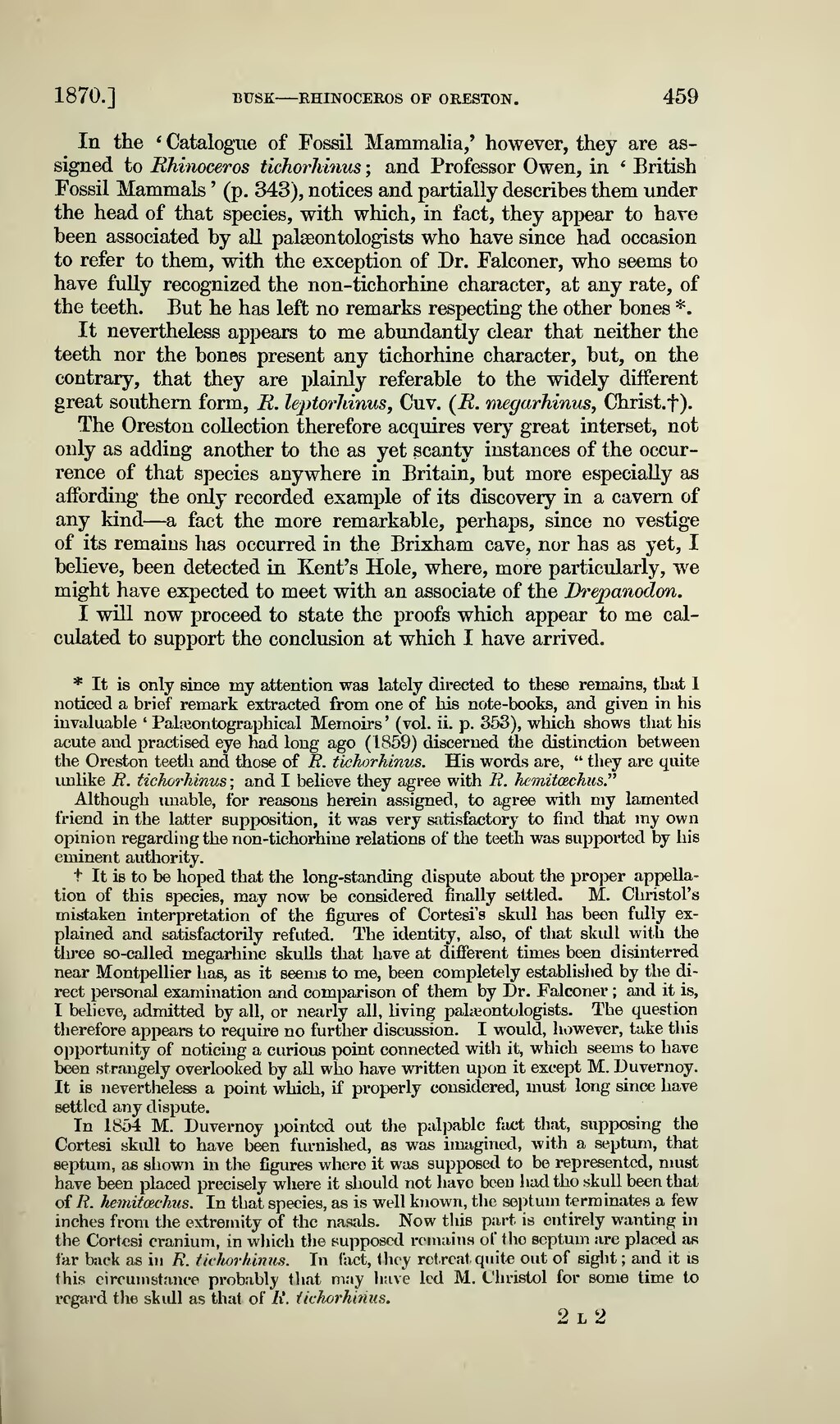1870.] BUSK RHINOCEROS OF ORESTON. 459
In the ' Catalogue of Fossil Mammalia,' however, they are assigned
to Rhinoceros tichorhinus ; and Professor Owen, in ' British
Fossil Mammals ' (p. 343), notices and partially describes them under
the head of that species, with which, in fact, they appear to have
been associated by all palaeontologists who have since had occasion
to refer to them, with the exception of Dr. Falconer, who seems to
have fully recognized the non-tichorhine character, at any rate, of
the teeth. But he has left no remarks respecting the other bones *.
It nevertheless appears to me abundantly clear that neither the teeth nor the bones present any tichorhine character, but, on the contrary, that they are plainly referable to the widely different great southern form, R. leptorhinus, Cuv. (R. megarhinus, Christ.†).
The Oreston collection therefore acquires very great interset, not only as adding another to the as yet scanty instances of the occurrence of that species anywhere in Britain, but more especially as affording the only recorded example of its discovery in a cavern of any kind — a fact the more remarkable, perhaps, since no vestige of its remains has occurred in the Brixham cave, nor has as yet, I believe, been detected in Kent's Hole, where, more particularly, we might have expected to meet with an associate of the Drepanodon.
I will now proceed to state the proofs which appear to me calculated to support the conclusion at which I have arrived.
- It is only since my attention was lately directed to these remains, that I
noticed a brief remark extracted from one of his note-books, and given in his invaluable ' Palaeontographical Memoirs ' (vol. ii. p. 353), which shows that his acute and practised eye had long ago (1859) discerned the distinction between the Oreston teeth and those of R. tichorhinus. His words are, " they are quite unlike R. tichorhinus; and I believe they agree with R. hemitoechus."
Although unable, for reasons herein assigned, to agree with my lamented friend in the latter supposition, it was very satisfactory to find that my own opinion regarding the non-tichorhine relations of the teeth was supported by his eminent authority.
† It is to be hoped that the long-standing dispute about the proper appellation of this species, may now be considered finally settled. M. Christol's mistaken interpretation of the figures of Cortesi's skull has been fully explained and satisfactorily refuted. The identity, also, of that skull with the three so-called megarhine skulls that have at different times been disinterred near Montpellier has, as it seems to me, been completely established by the direct personal examination and comparison of them by Dr. Falconer ; and it is, I believe, admitted by all, or nearly all, living palaeontologists. The question therefore appears to require no further discussion. I would, however, take this opportunity of noticing a curious point connected with it, which seems to have been strangely overlooked by all who have written upon it except M. Duvernoy. It is nevertheless a point which, if properly considered, must long since have settled any dispute.
In 1854 M. Duvernoy pointed out the palpable fact that, supposing the Cortesi skull to have been furnished, as was imagined, with a septum, that septum, as shown in the figures where it was supposed to be represented, must have been placed precisely where it should not have been had the skull been that of R. hemitoechus. In that species, as is well known, the septum terminates a few inches from the extremity of the nasals. Now this part is entirely wanting in the Cortesi cranium, in which the supposed remains of tho septum are placed as far back as in R. tichorhinus. In fact, they retreat quite out of sight ; and it is this circumstance probably that may have led M. Christol for some time to regard the skull as that of R. tichorhinus.
2l2
